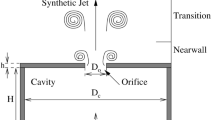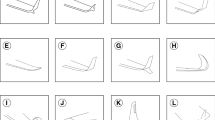Abstract
Submerged vanes are airfoils which are in general placed at certain angle with respect to the flow direction in a channel to induce artificial circulations downstream. By virtue of these artificially generated circulations, submerged vanes were utilized to protect banks of rivers against erosion, to control shifting of rivers, to avoid blocking of lateral intake with sediment deposition, etc. Odgaard and his associates have experimentally obtained the optimum vane sizes and recommended that it can be used for vane design. This paper is an attempt to review and validate the findings of Odgaard and his associates by utilizing computational fluid dynamics and experiments as a tool in which the vane generated vorticity in the downstream was maximized in order to obtain optimum vane parameters for single and multiple vane arrays.



















Similar content being viewed by others
References
Odgaard A J and Spoljaric A 1986 Sediment control by submerged vanes. J. Hydraulic Eng. ASCE 112(12): 1164–1181
Odgaard A J and Mosconi C E 1987 Stream-bank protection by submerged vanes. J. Hydraulic Eng. ASCE 113(4): 520–536
Odgaard A J and Wang Y 1991a Sediment management with submerged vanes. Theory: I. J. Hydraulic Eng. ASCE 117(3): 267–283
Wang Y and Odgaard A J 1993 Flow control with vorticity. J. Hydraulic Res. IAHR 31(4): 549–562
Odgaard A J and Kennedy J F 1983 River bend bank protection by submerged vanes. J. Hydraulic Eng. ASCE 109(8): 1161–1173
Han S S, Biron P M and Ramamurthy A S 2011 Three dimensional modeling of flow in sharp bends with vanes. J. Hydraulic Res. IAHR 49(1): 64–72
Voisin A and Townsend R D 2002 Model testing of submerged vanes in strongly curved narrow channel bends. Canadian J. Civil Eng. NRC Research Press 29: 37–49
Barkdoll B D, Ettema R and Odgaard A J 1999 Sediment control at lateral diversions: limits and enhancements to vane use. J. Hydraulic Eng. ASCE 125(8): 862–870
Wang Y, Odgaard A J, Melville B W and Jain S C 1996 Sediment control at water intakes. J. Hydraulic Eng. ASCE, 122(6): 353–356
Marelius F and Sinha S K 1998 Experimental analysis of flow past submerged vanes. J. Hydraulic Eng. ASCE 124(5): 542–545
Johnson P A, Hey R D, Tessier M and Rosgen D L 2001 Use of vanes for control of scour hole for vertical wall abutments. J. Hydraulic Eng. ASCE 127(9): 772–778
Tan S K, Guoliang Y, Lim S Y and Ong M C 2005 Flow structure and sediment motion around submerged vanes in open channel. J. Waterway, Port, Coastal Ocean Eng. ASCE 131(3): 132–136
Bhuyian F, Hey R D and Wormleaton P R 2010 Bank attached vanes for bank erosion control and restoration of river meanders. J. Hydraulic Eng. ASCE 136(9): 583–596
Gupta U P, Ojha C S P and Sharma N 2010 Enhancing utility of submerged vanes with collar. J. Hydraulic Eng. ASCE 136(9): 651–655
Flokstra C 2006 Modelling of submerged vanes. J. Hydraulic Res. IAHR 44(5): 591–602
Ouyang H T 2009 Investigation on the dimensions and shape of a submerged vane for sediment management in alluvial channels. J. Hydraulic Eng. ASCE 135(3): 209–217
Bertin J J and Smith M L 1979 Aerodynamics for engineers, First edition, Prentice Hall, New Jersey, USA
Ouyang H T, Lai J S, Yu H and Lu C H 2008 Interaction between submerged vanes for sediment management. J. Hydraulic Res. IAHR 46(5): 620–627
Sinha S K and Marelius F 2000 Analysis of flow past submerged vanes. J. Hydraulic Res. IAHR 38(1): 65–71
Allahyonesi H, Omid M H and Haghiabi A M 2008 A study of effects of longitudinal arrangement sediment behavior near intake structures. J. Hydraulic Res. IAHR 46(6): 814–819
Author information
Authors and Affiliations
Corresponding author
Rights and permissions
About this article
Cite this article
Sharma, H., Jain, B. & Ahmad, Z. Optimization of submerged vane parameters. Sādhanā 41, 327–336 (2016). https://doi.org/10.1007/s12046-016-0477-8
Received:
Revised:
Accepted:
Published:
Issue Date:
DOI: https://doi.org/10.1007/s12046-016-0477-8




